Family : Solanaceae

Text © Prof. Giorgio Venturini

English translation by Mario Beltramini
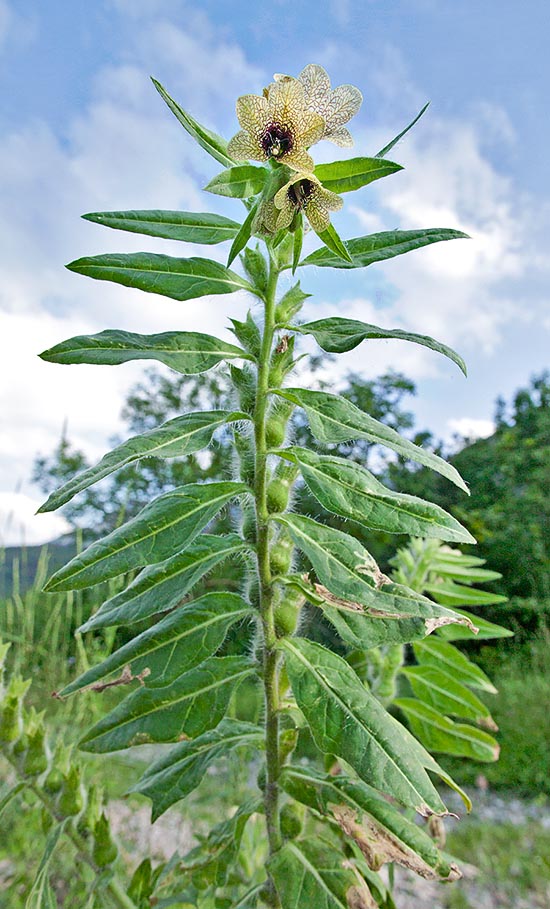
Diffused but rare, Hyoscyamus niger reaches 40-100 cm of height © Giuseppe Mazza
The name of the genus comes from the Greek “hyos” (ύος, genitive of ύς, meaning pig) (most common the form σύς sus, from which comes swine) and from “kyamos” (κυαμοσ) which means fava bean. The name therefore means “pig fava bean”, due to the fact that after the old tradition its poison is not effective on the pigs.
The name of the species “niger” = black in Latin, probably refers to the dark reticulation of the flower.
The Hyoscyamus niger is an annual or biennial, 40 to 100 cm tall, herbaceous plant, with acrid and unpleasant smell, well perceptible especially if crumpled, covered by sticky, silky and white hairs long up to 3 mm. The hairs are in part glandular and in part protective.
The stem is simple or little ramose at the extremity, erect. The leaves, alternate, darker in the upper page, are large, tender, simple, the upper ones sessile, the lower ones with petiole. The leave decrease in size from the base to the apex and may be 4 to 12 cm long. The upper leaves have big teeth, the lower ones with sinuous margin and small teeth.
Axillary flowers, subsessile, arranged like a compact terminal spike. Persistent campanulate calyx with 5 sharp teeth. Corolla long almost the double than the calyx, funnel shaped, with five lobes. Five stamina, pistil as long as the stamina. Bilocular ovary.
The flowers, which bloom in summer between June and August, are unmistakable, yellowish with a fine violet reticulation and mouth of dark vinous red colour. The fruit is a capsule with many small reniform brown seeds, operculate, opening for the dissemination.
It grows in the ruderal zones, close to old walls or middens, in rough and rich of nitrogen soil. It’s a plant diffused in all Europe, North Africa and Western Asia, where it goes up to India and Siberia. Introduced in the American continent, it has naturalized since the XVII century in North America.
In the Mediterranean region, is present also the Henbane (Hyoscyamus albus L.) which distinguishes from the previous one as having wholly petiolate leaves and yellow flower without violaceous reticulation. This species has the same pharmacological properties as the black henbane.
Easy to recognize by the yellowish flower with violet reticulum and vinous mouth © G. Mazza
The Egyptian henbane Hyoscyamus muticus contains the same alkaloids as the Hyoscyamus niger but with higher concentrations. In Egypt, the extract is called Sakran, which means “drunk, intoxicated”.
Toxicity and pharmacological properties
All parts of the plant are highly toxic. The toxicity and the pharmacological properties are analogous to those of other Solanaceae such as the Jimson weed (Datura stramonium) and the Deadly nightshade (Atropa belladonna), much different is on the contrary the toxicity of other Solanaceae such as the potato, the tomato, the bittersweet (Solanum dulcamara) or the duscle (Solanum nigrum) which contain the solanine.
The most important active principles of the Black henbane, of the Jimson weed and of the Deadly nightshade are the alkaloids Scopolamine or Hyoscine, Atropine (DL-Hyoscyamine), and L-Hyoscyamine (also the Mandrake). All these substances have the same effects and inhibit the link of the neurotransmitter acetylcholine to its muscarinic receptors (there are two subclasses of receptors for the acetylcholine, called nicotinic and muscarinic for the pharmacological sensitivity respectively to the nicotine and to the muscarine, produced by the fungus Amanita muscaria).
The muscarinic receptors are involved in the functioning of the parasympathetic autonomic nervous system as well as of the central nervous system. The autonomic nervous system regulates the functions of our internal organs; we distinguish an “ortosympathetic” with generally excitatory functions, activated during the emergencies (it is called “fight-or-flight”) and a “parasympathetic” system activated when the organism is resting (called “rest-and-digest”).
The good functioning of our internal organs is therefore is governed by a balance of the activities of the two systems. The alkaloids of the black henbane cause therefore an inhibition of the parasympathetic system (and the consequent activation of the ortosympathetic one) and interfere also with some activities of the central nervous system. At effective doses the effects are: amnesia, hallucinations, block of salivary, gastric and intestinal secretion, inhibition of the vasodilatation, pupil dilation, tachycardia, nausea, vomiting and, in excessive doses, coma and death.
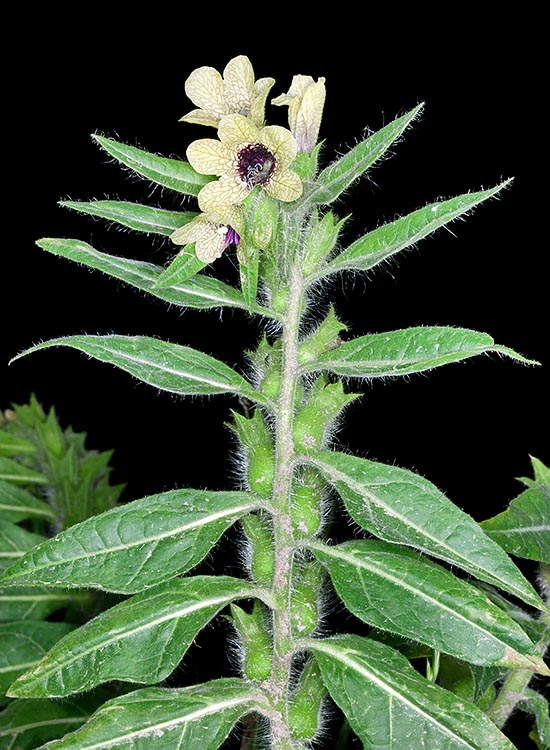
All parts of the plant are highly toxic and may aver fatal © Giuseppe Mazza
The content in active substances of the black henbane is lower than that of the jimson weed or the deadly nightshade and so the dangerousness may be considered as inferior. Seen however the very remarkable toxicity, the use of all parts of the plant is quite dangerous. The conditions of growth of the plant vary considerably the contents in active substances and it is therefore very difficult to determine the doses, with serious risk of overdoses. It has been utilized as antispasmodic in case of colics, as somniferous or as diuretic. As liniment for rheumatic pains has been used a maceration of leaves in alcohol mixed with olive oil and a mush of chopped leaves for the gout discomforts. They prepared also suppositories for haemorrhoids. The smoke obtained by warming the seeds or the seeds themselves were used for the tooth-ache. Under form of extract or tincture, it was used as analgesic or sedative. Drops of tincture were directly applied in the cavity of dental caries to ease the pain. The black henbane is still used in the homeopathic preparations as antitussive, in the infections of eyes and ears, tooth-ache, convulsions and hysteria.
The leaves of the black henbane along with those of deadly nightshade and jimson weed serve to prepare anti-asthmatic cigarettes and are considered effective for the bronchospasm.
The watery extract applied to the eye causes dilation of the pupil (nowadays for ophthalmic purposes, for observing the ocular fundus as well as for preparing the eye to surgical interventions, is used the purified atropine).
The root and the seeds usually are not utilized. It is known however that they contain the same substances at much greater concentrations than the leaves and consequently the potential risk of intoxications for overdose is greater.
Presently, for most of the medical applications they use purified alkaloids, that is, atropine and scopolamine. It would be impossible to list all the applications and therefore here we limit to report some examples, some real, others hypothetical.
Poisonings by nerve gasses and by organophosphate insecticides
Atropine and scopolamine are used as antidotes for poisonings by nerve gasses such as the Sarin or by organophosphate insecticides such as Malathion or Parathion. These substances act as cholinesterase inhibitors (they inhibit the enzymes which degrade the acetylcholine). The increased availability of acetylcholine causes a hyperactivity of its receptors which is the cause of the damages.
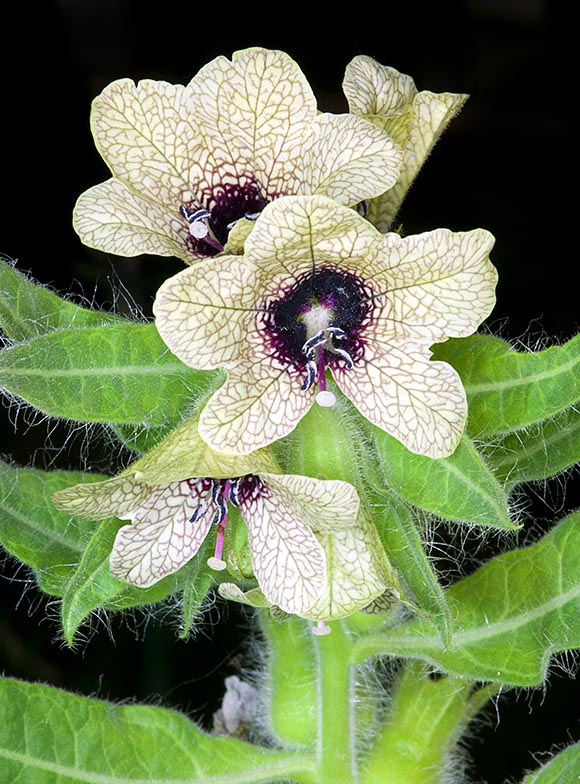
The upper leaves, sessile, often do have big teeth © Giuseppe Mazza
The scopolamine is applied for the treatment and the prevention of the kinetosis, that is, of the seasickness or of the carsickness.
The scopolamine id effective as it reduces the activity of the acetylcholine in the vestibular system of the inner ear, which is the organ of the balance, sensitive to the movements (in case of seasickness, the muscarinic receptors of the vestibular system are hyperstimulated by the movements of the vessel and transmit the signal at central level, causing the vomit due to excess of stimuli). The scopolamine is given by means of transdermal patches or chewing gums.
Truth serum
The use of the scopolamine as truth serum has been tried since the mid of the ‘900 also by CIA and by other intelligence agencies and maybe previously by the Nazis. However, the result has been that the hallucinogenic effects cause alteration of the perception of the reality and therefore the assertions of the person questioned are completely unreliable. Its use as “truth serum” has been, therefore, abandoned.
History and literature
The medical use of the black henbane is documented since the ancient times. In the Egyptian Ebers Papyrus it is mentioned as sedative for the toothache.
Dioscorides (1st century after Christ) suggests its oral or local use for calming the pain and reports its toxicity.
Recently evidence for its earlier use in the Scottish Neolithic has been debated (Black Henbane (Hyoscyamus niger L.) in the Scottish Neolithic, Journal of Archaeological Science (1999) 26, 45-52).
Shakespeare attributes to the Black henbane the death of Hamlet father: Hamlet, Act one, Scene five. The spectre of Hamlet reveals to the son the cause of his death:
‘… With juice of cursed hebenon in a vial, And in the porches of mine ear did pour The leprous distillment …’
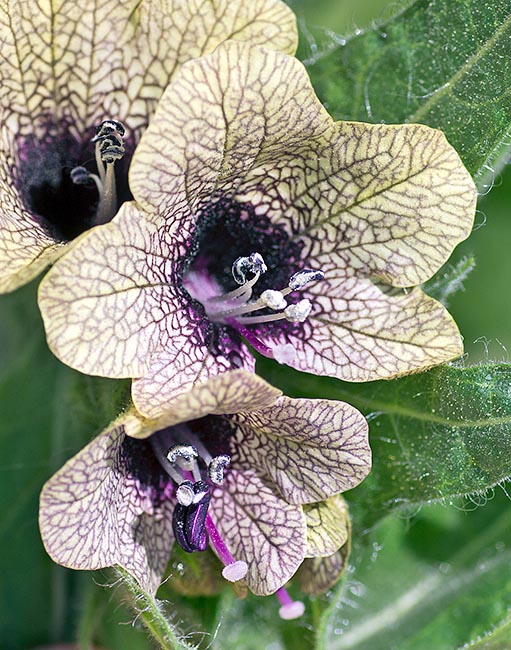
Five stamina, pistil as long as them. Bilocular ovary © Giorgio Venturini
Moreover, the administration of the black henbane in the ear is already reported by Pliny (Naturalis Historia, libro XXV, 35-37), who attributes to the drug an effect on the mind:
‘….Of the wine the nature, which therefore affects the mind and the head… an oil from the seed, as we have said, the same that, infused into the ears disturbs the mind…’
In the Middle Ages they used as anaesthetic for surgeries the “spongia somnifera”: a sponge imbued with mandrake, black henbane, opium and other drugs which made to sniff to the patient. It has been thought that also the sponge offered to the Christ on the cross might have that function. Already Cleopatra used the extract of the Egyptian black henbane for dilating the pupils for aesthetic purposes, in order to get a sensual and seductive look (who knows if she has in this way seduced Julius Caesar and Antony); this cosmetic use diffused in the Renaissance (using, however, Atropa belladonna) and was resumed in the “belle époque” Paris (the term belladonna rightly refers to this utilization).
From Cleopatra we reach our days with Diabolik: seen that the black henbane alkaloids can cause alteration of the consciousness followed by amnesia, the scopolamine could be administered dissolved in drinks to the unaware victim to induce her to commit robberies or other crimes. Diabolik uses the scopolamine for his criminal purposes to avoid the will of the persons obliging them to obey his orders. The idea is reasonable and probably the case has occurred also in the reality.
Intoxications
Seen the high toxicity of these compounds, several are the instances of fatal intoxication by solanaceae and numerous those of serious intoxication, mainly by young who take infusions as narcotics.
The window between the actve dose and the fatal one is very narrow and this causes a consequent high risk in the taking. The oddest case is that of a monastery where the monks mistook the Black henbane with the chicory and used it for preparing the soup. During the night, all were taken from delirium and hallucinations (we can imagine the situation in this awful monastery!). More commonly, it is the case of children who swallow the seeds or of reckless use for self-medications.
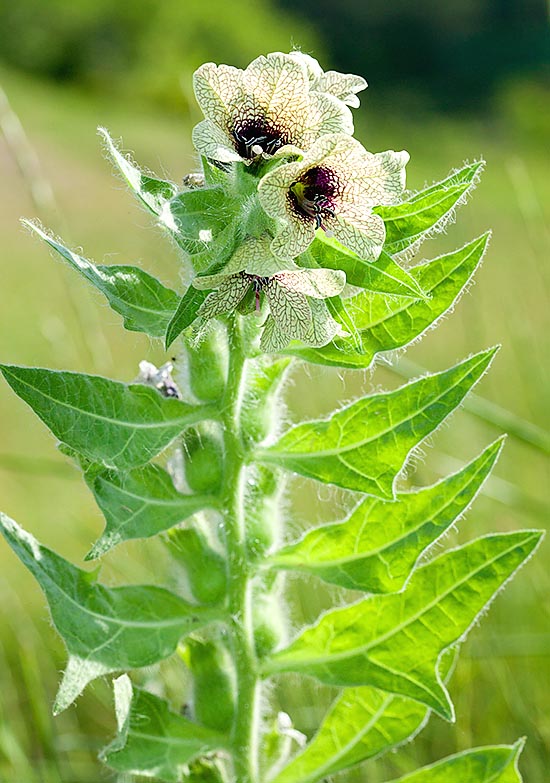
Ingredient of the witches Sabbath, causes hallucinations and flight feeling © Giuseppe Mazza
Several cases of poisoning in the cattle have occurred, in some cases due to black henbane voluntarily added to the fodder by the breeders, in the conviction of rendering the animals fat. Not all animals are subject to the toxicity of these solanaceae: the caterpillars of numerous lepidopterans in fact eat the black henbane.
The antidote to use for the black henbane intoxications or by other solanaceae such as the deadly nightshade, jimson weed or mandrake is the physostigmine, originally extracted from the Calabar bean (Physostigma venenosum), belonging to the family of the fabacee This substance acts inhibiting the enzyme which destroys the acetylcholine, whose availability consequently increases and causes a stimulation of those receptors which are, on the contrary, inhibited by the black henbane toxic substances. The use of the physostigmine is in any case risky and must be done only under strict medical control and only in the most serious cases of intoxication.
A curious thing
In 2008, the famous British chef Anthony Worrall Thompson on a well known cooking magazine has recommended the addition of black henbane in the salads for improving their taste. Later on, he has rushed to publish a retraction, saying, as justification, of having mistaken the black henbane with the fat hen. The magazine has sent to the subscribers an urgent message of retraction, recommending to never eat the black henbane.
Magic and legendary uses
The black henbane was sacred to Apollo, oracular god, and was used by the priests of the temples of the god for inducing the hallucinatory status necessary to produce the oracles. In the Hades, the dead who were wandering along the Styx were crowned with leaves of black henbane.
In the late Middle Ages and probably also in previous ages, they prepared with the black henbane potions and ointments which, if used, gave hallucinations and the feeling of flying, for this reason the black henbane is deemed as an ingredient of the famous ointment or salve of the witches, along with the jimson weed, the mandrake and the deadly nightshade, used for getting ready to the Sabbath (which consequently was a mental travel analogous to that typical of all the prophets and the shamans).
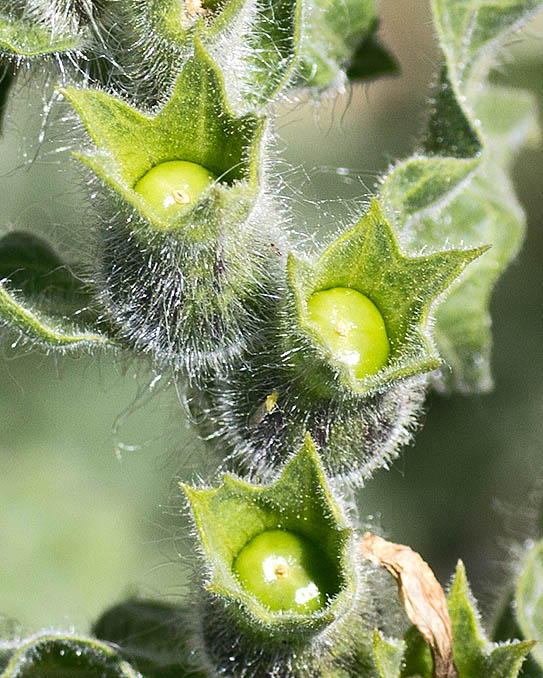
The fruit, brown when ripe, is a capsule with many tiny reniform seeds © Giorgio Venturini
Bold modern scholars have reproduced these salves experiencing them on themselves, with the result of flying hallucinations and deep sleep with visions of monstrous animals. It is clear that then, when the witches were questioned by the inquisitors, they sincerely told their experiences confessing flights and meetings with the Devil.
In the “Malleus maleficarum”, the fifteenth century book considered a sort of treatise for hunting the witches, the typical hallucinatory effects of the black henbane were rightly described as proofs allowing to identify a witch.
For the Celts, it was sacred to the sun, and then identified with Apollo. The Druids used it for reaching the enlightenment.
Bizarre enchantments have been described into the sixteenth-century pharmacopoeia: a filter composed by black henbane and other ingredients was believed being able to instantaneously kill a rabid dog, or to explode a silver calyx inside it; if mixed with the blood of a hare, and placed on the skin of the same hare, this could be used for attracting and seizing other hares.
After Albertus Magnus, when burning the black henbane mixed with the blood of female hoopoe, all the people present get hallucinations: this is absolutely believable seen the properties of the plant, even if the hoopoe blood might aver not essential.
Other utilizations
The black henbane was used in the production of the beer, as one of the components of the “gruit”, a mix of herbs used for savouring the beer before the introduction of the hops (who knows, maybe it rendered the beer also more intoxicant). In recent times, the producers of craft beers bringing back blends alternative to the hops.
Synonyms: Hyoscyamus pallidus Waldst. & Kit. ex Willd.; Hyoscyamus auriculatus Ten.; Hyoscyamus bohemicus F.W.Schmidt.
→ To appreciate the biodiversity within the SOLANACEAE family please click here.
